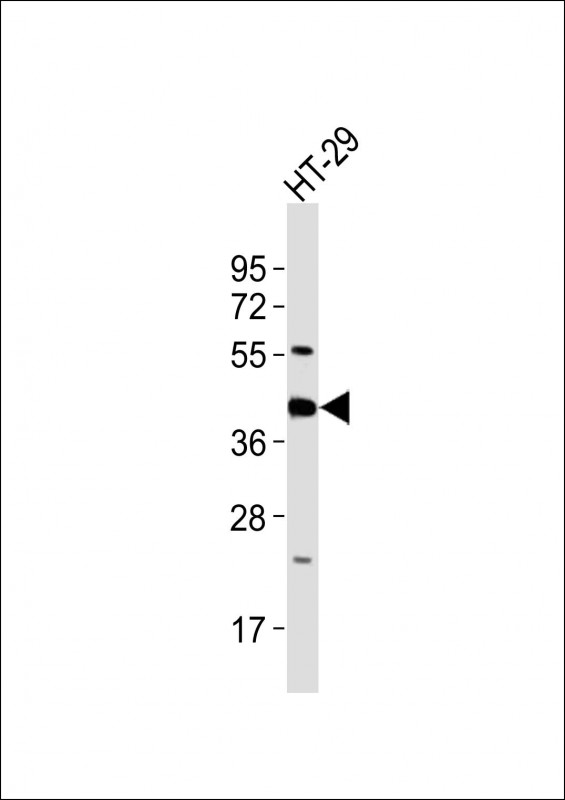GNAI3 Antibody
Purified Rabbit Polyclonal Antibody (Pab)
- 产品详情
- 实验流程
- 背景知识
Application
| WB, E |
|---|---|
| Primary Accession | P08754 |
| Reactivity | Human, Rat, Mouse |
| Host | Rabbit |
| Clonality | polyclonal |
| Isotype | Rabbit IgG |
| Calculated MW | 40532 Da |
| Gene ID | 2773 |
|---|---|
| Other Names | Guanine nucleotide-binding protein G(k) subunit alpha, G(i) alpha-3, GNAI3 |
| Target/Specificity | This GNAI3 antibody is generated from a rabbit immunized with a KLH conjugated synthetic peptide between 309-343 amino acids from the human region of human GNAI3. |
| Dilution | WB~~1:2000 E~~Use at an assay dependent concentration. |
| Format | Purified polyclonal antibody supplied in PBS with 0.09% (W/V) sodium azide. This antibody is purified through a protein A column, followed by peptide affinity purification. |
| Storage | Maintain refrigerated at 2-8°C for up to 2 weeks. For long term storage store at -20°C in small aliquots to prevent freeze-thaw cycles. |
| Precautions | GNAI3 Antibody is for research use only and not for use in diagnostic or therapeutic procedures. |
| Name | GNAI3 |
|---|---|
| Function | Heterotrimeric guanine nucleotide-binding proteins (G proteins) function as transducers downstream of G protein-coupled receptors (GPCRs) in numerous signaling cascades. The alpha chain contains the guanine nucleotide binding site and alternates between an active, GTP-bound state and an inactive, GDP-bound state. Signaling by an activated GPCR promotes GDP release and GTP binding. The alpha subunit has a low GTPase activity that converts bound GTP to GDP, thereby terminating the signal (By similarity). Both GDP release and GTP hydrolysis are modulated by numerous regulatory proteins (PubMed:18434541, PubMed:19478087, PubMed:8774883). Signaling is mediated via effector proteins, such as adenylate cyclase. Inhibits adenylate cyclase activity, leading to decreased intracellular cAMP levels (PubMed:19478087). Stimulates the activity of receptor-regulated K(+) channels (PubMed:2535845). The active GTP-bound form prevents the association of RGS14 with centrosomes and is required for the translocation of RGS14 from the cytoplasm to the plasma membrane. May play a role in cell division (PubMed:17635935). The active GTP-bound form activates the calcium permeant TRPC5 ion channels (PubMed:37137991). |
| Cellular Location | Cytoplasm. Cell membrane; Lipid-anchor. Cytoplasm, cytoskeleton, microtubule organizing center, centrosome Note=Localizes in the centrosomes of interphase and mitotic cells Detected at the cleavage furrow and/or the midbody |
For Research Use Only. Not For Use In Diagnostic Procedures.
Provided below are standard protocols that you may find useful for product applications.
BACKGROUND
Guanine nucleotide-binding proteins (G proteins) are involved as modulators or transducers in various transmembrane signaling systems. G(k) is the stimulatory G protein of receptor- regulated K(+) channels. The active GTP-bound form prevents the association of RGS14 with centrosomes and is required for the translocation of RGS14 from the cytoplasm to the plasma membrane. May play a role in cell division.
REFERENCES
Didsbury J.R.,et al.FEBS Lett. 219:259-263(1987).
Beals C.R.,et al.Proc. Natl. Acad. Sci. U.S.A. 84:7886-7890(1987).
Itoh H.,et al.J. Biol. Chem. 263:6656-6664(1988).
Codina J.,et al.J. Biol. Chem. 263:6746-6750(1988).
Kim S.,et al.Proc. Natl. Acad. Sci. U.S.A. 85:4153-4157(1988).
终于等到您。ABCEPTA(百远生物)抗体产品。
点击下方“我要评价 ”按钮提交您的反馈信息,您的反馈和评价是我们最宝贵的财富之一,
我们将在1-3个工作日内处理您的反馈信息。
如有疑问,联系:0512-88856768 tech-china@abcepta.com.























 癌症的基本特征包括细胞增殖、血管生成、迁移、凋亡逃避机制和细胞永生等。找到癌症发生过程中这些通路的关键标记物和对应的抗体用于检测至关重要。
癌症的基本特征包括细胞增殖、血管生成、迁移、凋亡逃避机制和细胞永生等。找到癌症发生过程中这些通路的关键标记物和对应的抗体用于检测至关重要。 为您推荐一个泛素化位点预测神器——泛素化分析工具,可以为您的蛋白的泛素化位点作出预测和评分。
为您推荐一个泛素化位点预测神器——泛素化分析工具,可以为您的蛋白的泛素化位点作出预测和评分。 细胞自噬受体图形绘图工具为你的蛋白的细胞受体结合位点作出预测和评分,识别结合到自噬通路中的蛋白是非常重要的,便于让我们理解自噬在正常生理、病理过程中的作用,如发育、细胞分化、神经退化性疾病、压力条件下、感染和癌症。
细胞自噬受体图形绘图工具为你的蛋白的细胞受体结合位点作出预测和评分,识别结合到自噬通路中的蛋白是非常重要的,便于让我们理解自噬在正常生理、病理过程中的作用,如发育、细胞分化、神经退化性疾病、压力条件下、感染和癌症。






